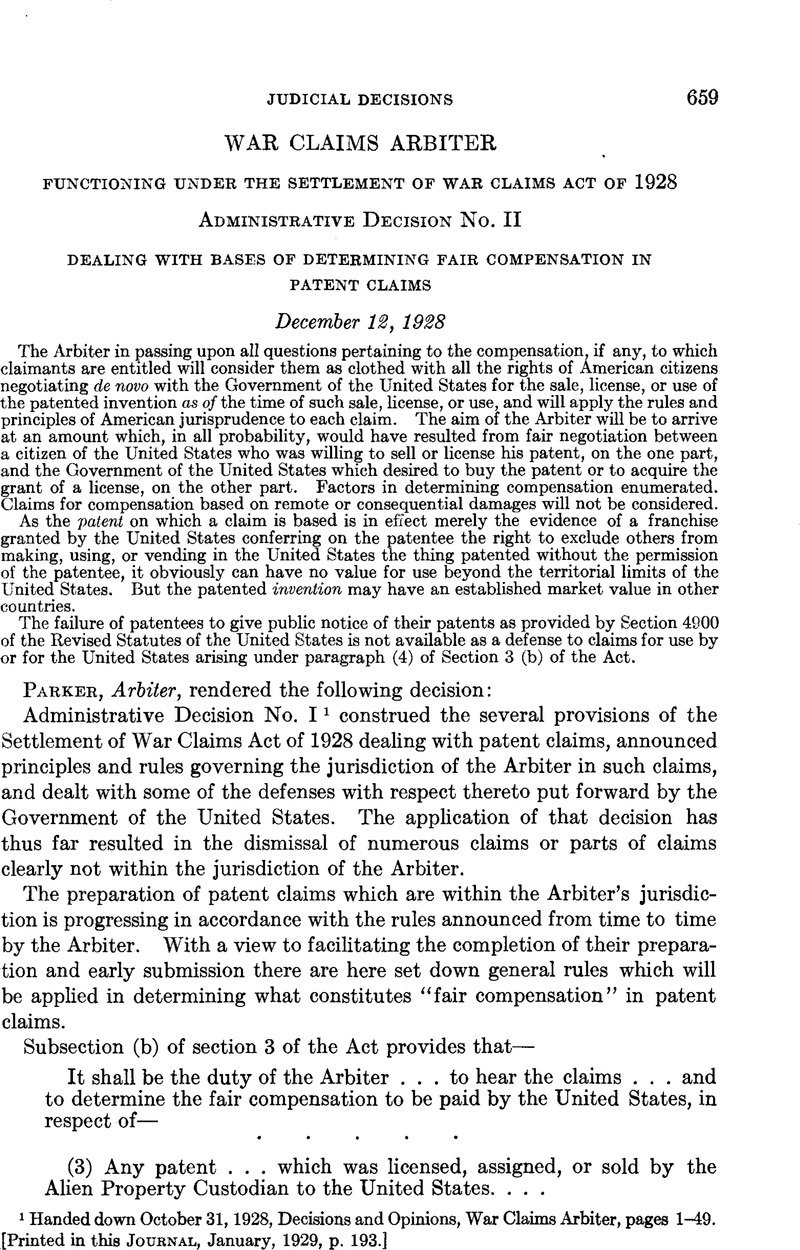No CrossRef data available.
Published online by Cambridge University Press: 04 May 2017

1 Handed down October 31,1928, Decisions and Opinions, War Claims Arbiter, pages 1-49.[Printed in this Journal , January, 1929, p. 193.]
2 40 Stat. 411.
3 United States Shoe Machinery Corporation v. United States (1922), 258 U. S. 451, 463.
4 Brooks-Scanlon Corporation v. United States (1924), 265 U. S. 106; Berdan FireArms Manufacturing Co. v. United States (1890), 26 Court of Claims 48, 79, affirmed by the Supreme Court of the United States, 156 U. S. 552. See also Seaboard Air Line Railway Co. v. United States (1923), 261 U. S. 299.
5 Pasqueau v. United States (1891), 26 Court of Claims 509.
6 The substantial uniformity or absence thereof of such fees or royalties must be taken into account and they must be sufficient in number to justify the conclusion that a willin purchaser could afford to pay that price. Rude v. Westcott (1889), 130 U. S. 152. The sale of a single license is of but small probative value; Judson v. Bradford (1878), 3 Banning and Arden Patent Causes 549; Walker on Patents, 5th edition, section 557.
7 Cornely v. Marckwald (1889), 131 U. S. 159; Rose v. Hirsh (1899), 94 Fed. 177; Underwood Typewriter Co. v. E. C. Stearns & Co. (1915), 227 Fed. 74, 82.
8 Suffolk Manufacturing Co. v. Hayden (1866), 70 U. S. 315; Austin-Western Road Machinery Co. v. Disc Grader & Plow Co. (1923), 291 Fed. 301, 304; McKeever v. United States (1879), 14 Court of Claims 396, 425; Talbert v. United States (1890), 25 Court of Claims 141; Berdan Fire-Arms Manufacturing Co. v. United States (1890), 26 Court of Claims 48, 79, affirmed by Supreme Court of the United States, 156 U. S. 552.
9 Sessions v. Romadka (1892), 145 U. S. 29, 45; Brickill v. Mayor, etc., of Baltimore (1894), 60 Fed. 98; Walker on Patents, sec. 725 et seq.; United States Frumentum Co. v. Lauhoff (1914), 216 Fed. 610. The advantage which is contemplated by this rule is the result of some superiority of the claimant's invention over the standard of comparison and that superiority may consist in the fact that the claimant's invention performs thefunctions common to both with equal cheapness and greater excellence, or with greater cheapness and equal excellence, or with greater cheapness and greater excellence; and therefore the advantage may consist either in affirmative gain or in saving from loss or in both of these elements. Providence Rubber Co. v. Goodyear (1870), 76 U. S. 788; Mowry v. Whitney (1872), 81 U. S. 620, 651.
10 Seymour et al. v. McCormick (1853), 57 U. S. 480; Merrell Soule Co. v. Powdered Milk Co. (1925), 7 Fed. (2d) 297.
11 Porter Needle Co. v. National Needle Co. (1885), 22 Fed. 829; Walker on Patents, sec. 562.
12 Willimantic Thread Co. v. Clark Thread Co. (1886), 27 Fed. 865.
13 This group of cases does not involve compensation for property acquired but rather compensation for the use of the inventions without the acquisition of the right to use. These cases are analogous to patent infringement cases, and the decisions of the United States courts in such cases will guide in determining the amount of compensation to be awarded under paragraph (4). Suffolk Manufacturing Co. v. Hayden (1866), 70 U. S. 315; Dowagiac Manufacturing Co. v. Minnesota Moline Plow Co. (1915), 235 U. S. 641, 648; Austin-Western Road Machinery Co. v. Disc Grader & Plow Co. (1923), 291 Fed. 301, 304
14 Berdan Fire-Arms Manufacturing Co. v. United States (1890), 26 Court of Claims, 48, 81, affirmed by Supreme Court of the United States, 156 U. S. 552.
15 Section 4900 in its present form reads as follows: “ It shall be the duty of all patentees and their assigns and legal representatives, and of all persons making or vending any patented article for or under them, to give sufficient notice to the public that the same is patented; either by fixing thereon the word ‘ patent, together'with the number of the patent, or when, from the character of the article, this can not be done, by fixing to it, or to the package wherein one or more of them is enclosed, a label containing the like notice: Provided, however, That with respect to any patent issued prior to April 1, 1927, it shall be sufficient to give such notice in the form following, viz.: ’ Patented,’ together with the day and year the patent was granted; and in any suit for infringement by the party failing so to mark, no damages shall be recovered by the plaintiff, except on proof that the defendant was duly notified of the infringement and continued, after such notice, to make, use, or vend the article so patented.”